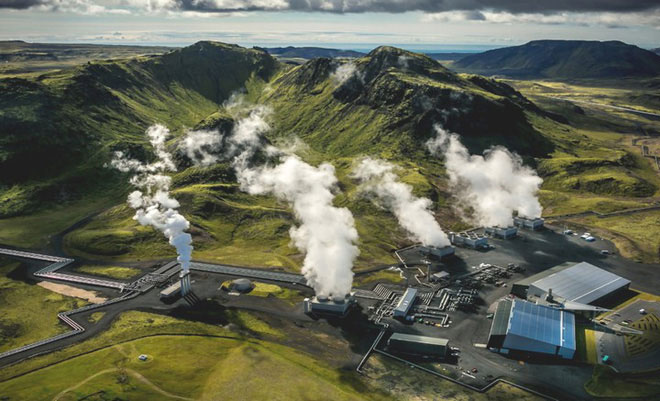Iceland successfully tested the method of 'capturing and confining' CO2 permanently into the ground
An international team of scientists has found a specific way to store CO2 in rocks deep underground.
The amount of CO2 in the atmosphere is reaching a record level and according to recent data, the number has reached 415 parts per million (ppm). High concentrations of CO 2 in the atmosphere are one of the leading causes of climate change and warming the Earth by preventing natural cooling and cooling mechanisms.
It is worth mentioning that most of CO 2 is generated from human industrialization and widespread deforestation. If people want to avoid natural disasters due to global average temperatures exceeding 2 degrees Celsius by the end of this century, in addition to actively planting more trees, limiting greenhouse gas emissions, we can also Create CO2 air cleaners to clean the atmosphere.

Iceland recently took a big step in the fight to protect the Earth when it introduced the method of turning CO 2 into building materials after more than two years of experimentation. The system called CarbFix is a collaboration between researchers and engineers of Reykjavik Energy, the University of Iceland, the French National Center for Scientific Research (CNRS) and Columbia University, USA.
The CarbFix system is responsible for capturing and trapping CO 2 as a production material. Reportedly, researchers have simulated natural processes that last for thousands of years but only take a short time to create. The operation of the system starts by injecting CO2 into porous basalt. The mineralization phenomenon in rock will catch and confine CO 2 permanently in it.
It took the team two years to set up Hellisheidi geothermal power lab to evaluate the new system. This is one of the world's largest geothermal power plants located on Mount Hengill in southwest Iceland. The plant is located on a layer of basalt formed from volcanic lava. Therefore, Hellisheidi can access almost endless water pumped up from under the volcano to run 6 turbines and provide electricity and hot air to the capital of Iceland.
At the end of 2018, after many years of experimentation, the CarbFix project team pumped about 43,000 tons of CO2 into the ground.
CO2 from this process will be collected by the steam of the plant. Then the water vapor containing CO2 will be liquefied and transported to an area a few kilometers away. The water will eventually flow into the basalt layer at a depth of 1000m and initiate the solidification process, a chemical reaction occurs when air comes into contact with calcium, magnesium and iron in basalt.
Thus almost all CO2 has been turned into minerals and exists safely underground permanently and no longer poses a danger to the climate.

Snaebjornsdottir, a researcher at the CarbFix project, said: "Most of the CO2 pumped into the rock has been mineralized within 2 years of the start of the trial . " The CarbFix project promises to help reduce 1/3 of CO 2 by Hellisheidi power plant. This figure amounts to 12,000 tons of CO 2 and costs only about 25 USD / ton.
Of course, this project still has a drawback, that is, the process of storing CO2 requires a huge amount of water. For every ton of CO2 pumped in, scientists need to use about 25 tons of water. But according to scientists, water can circulate and reuse after CO 2 is removed from the water. Of course they also have to desalinate in water to be able to reuse.
But the project could not guarantee that Iceland could become a model country, go against climate change. According to the Paris agreement signed in 2015, Iceland agreed to cut 40% of greenhouse gas emissions by 2030. However, according to the Icelandic Environmental Agency report, the country's emissions have increased by 2.2%. in the period 2016-2017 and has increased 85% since 1990.
- At room temperature, RMIT scientists turned CO2 into coal, buried in the ground
- German scientist found a way to turn air conditioning into a CO2 vacuum, preventing the Earth from heating up
- Want to see the sun all day without diving, go to Iceland!
- Unbelievable facts about Iceland
- Testing ground photography with hot air balloons
- The whole country of Iceland has only one mosquito, it is also soaked in alcohol and put into a museum
- See the mesmerizing beauty of Iceland nature
- Camera works permanently
- Beautiful scenery of Iceland through the perspective of Vietnamese photographer
- Technology of extracting jasmine essential oil and applying in tea industry
- Video: Beautiful Iceland under the view of Drones
- Volcanoes in Iceland wake up after 200 years
- Successfully tested 10 new compounds against cancer
- China successfully tested fusion energy reactors
 Is the magnetic North Pole shift dangerous to humanity?
Is the magnetic North Pole shift dangerous to humanity? Washington legalizes the recycling of human bodies into fertilizer
Washington legalizes the recycling of human bodies into fertilizer Lightning stone - the mysterious guest
Lightning stone - the mysterious guest Stunned by the mysterious sunset, strange appearance
Stunned by the mysterious sunset, strange appearance